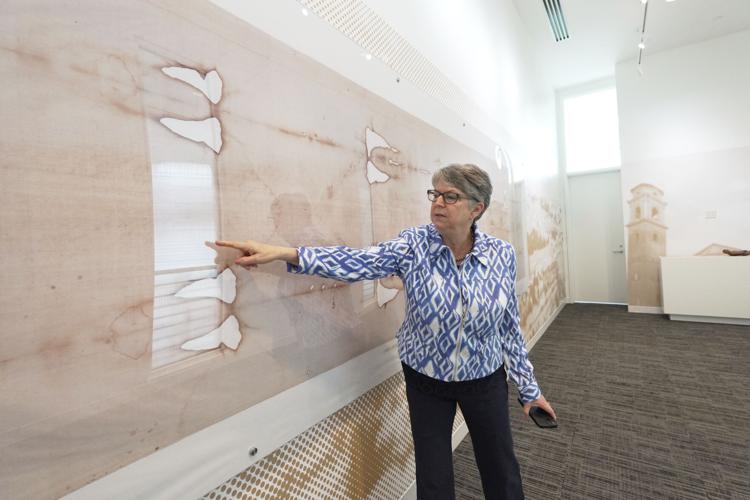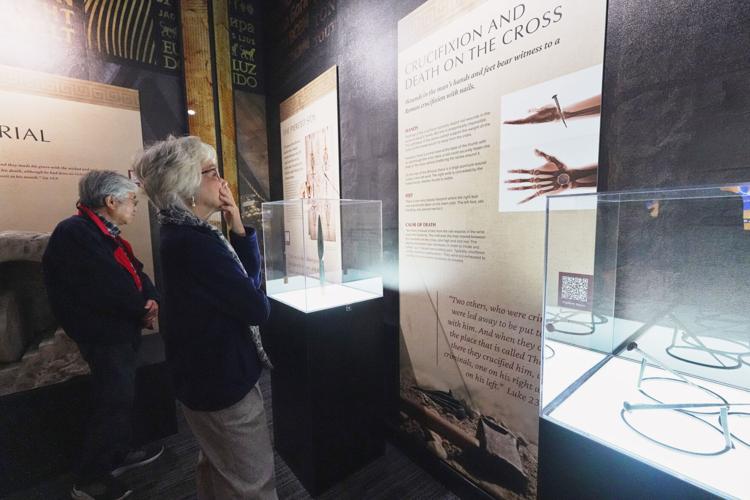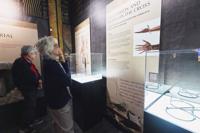GARDEN GROVE, Calif. (AP) — An interactive museum dedicated to the Shroud of Turin, which some say was Jesus’ burial cloth, opens its doors to the public Wednesday at the Christ Cathedral campus in Southern California.
“The Shroud of Turin: An Immersive Experience,” a $5-million exhibit in Garden Grove featuring 360-degree projection room theaters, Shroud of Turin replicas, interactive kiosks, and a life-size sculpture of Christ, was conceived over a span of three years and funded through private donations.
The content was created primarily by Othonia, Inc., a Rome-based group dedicated to the examination of the shroud, one of the most studied artifacts in history. The original — a 14-foot-long, 3.5-foot-wide (4.3-meter-long, 1 meter-wide) cloth — is kept in a bulletproof, climate-controlled case housed in the Cathedral of Saint John the Baptist in Turin, Italy.
The California museum — covering 10,000 square feet (930 square meters) — contains a life-size laminated visual of the shroud stretched over a wall. It shows the faint image of a man with wounds similar to those of Christ.
The cloth is a powerful symbol for Christians
The Vatican has called the cloth a powerful symbol of Christ’s suffering while making no claim to its authenticity. Many experts stand by carbon-dating of scraps of the cloth that put it in the 13th or 14th century, but many faithful — some accomplished scientists among them — say the results might have been skewed by contamination, calling for larger samples to be analyzed. Many insist that the cloth contains pollen from Jerusalem and is woven in a pattern that was unique to the first century.
The cloth, considered a relic by many Christians, was most recently on display in the spring of 2015. While the shroud may never leave Turin, the new exhibit will remain at least through 2030 on the Christ Cathedral campus, next to the famous glass tower and sanctuary erected by televangelist Robert H. Schuller that is now home to the Catholic Diocese of Orange.
The Most Rev. Timothy Freyer, an auxiliary bishop at the diocese, said he hopes the exhibit will reinforce for visitors the power of God’s love for all.
“My hope is that people of faith will have stronger faith, people who are doubting will come to belief and people with no faith will begin the questioning process and then come to faith,” he said.
One of the highlights of the immersive experience is a re-creation of Christ’s resurrection on Easter morning, with museum visitors sitting in the tomb and watching the shrouded body disappear in a flash of light. The exhibit also features replicas of the spear believed to have pierced Christ’s chest and the helmet of thorns placed on his head.
Philip Rizzo, a parishioner at St. Bonaventure Catholic Church in Huntington Beach who was part of a group that got a preview, said seeing these items up close created a powerful visual representation of Christ’s suffering and sacrifice. Also, he said, witnessing the extensive scientific research conducted on the cloth makes the artifact more relatable.
“We’re tangible beings, not just spirit and light,” Rizzo said. “Science really helps make that connection.”
The subject of extensive research
While some scientists have criticized the eagerness of Christians to authenticate the cloth, the new exhibit had its origins in such curiosity. Its main proponent was August Accetta, a gynecologist who opened up the Shroud Center of Southern California in 1998 and has studied the cloth's mystery for over three decades.
Accetta said it was the Shroud of Turin that converted him from agnostic to Catholic. His Shroud fascination continued after meeting John Jackson, a nuclear physicist, who in 1978 led a 40-person team of scientists as part of the Shroud of Turin Research Project. Their study determined that the cloth was not a manufactured work of art, but contained human bloodstains and that no known physical, chemical or biological process could adequately explain how the image on the Shroud was formed.
Accetta believes, as some other scientists do, that the image was created by a burst of radiation and that a massive amount of energy is required to create the image without burning the cloth.
“On the shroud, you see four centimeters of anatomically correct information encoded in two microns, which is about half the thickness of a strand of hair,” he said. “We can’t even begin to understand that, let alone reproduce it.”
To him, the only explanation — as the interactive exhibit illustrates — is that the body of Christ became light and the shroud simply collapsed, leaving the fine imprint of his face on the white linen.
The Rev. Robert Spitzer, founder of the Magis Center, a nonprofit that uses science to defend the Catholic faith, said the cloth bears “perfect blood stains down to the edges,” which does not happen when a shroud is simply pulled off a dead body. The stains should be smeared and fragmented if that were the case, he said. Like Accetta, Spitzer says the etching on the cloth was likely caused by particle radiation.
“And then one 10,000th of a second after the discharge begins, whap! These blood stains are transferred perfectly onto the cloth,” Spitzer said. "The only explanation is that body has to disappear. I mean — like Frodo’s ring — it’s gone.”
Where science meets faith
Spitzer added that he does not need a relic to explain his faith because that comes from his belief in Scripture and Christ’s resurrection.
“But it’s given me a little deeper insight into God and how he works,” he said.
Nora Creech, director of Othonia in the U.S., said the Rome-based organization was founded by the Rev. Hector Guerra, who dreamed of creating 100 exhibits globally. He built the first flagship exhibit in Jerusalem and others in Rome, Poland, Mexico and the U.S. This latest one is the first to feature an immersive experience, which was created by a California-based studio.
Creech said they decided to begin the movielike immersive experience with Christ’s life story from birth to crucifixion and end with the resurrection and the message that “Jesus is still with us today.”
“One of the quotes in the movie is that the cross received Jesus alive and turned him over to the shroud, dead. The shroud received Jesus dead and turned him over to us alive in the Eucharist,” she said.
Rudy Dicthtl, one of the scientists who formed the 1978 research team, still remembers every moment spent touching and holding the cloth in his hands. He said he and the other scientists walked into the project with the understanding that they would leave the moment they saw the cloth was a forgery or a manufactured piece of art. Their research found that it was not.
“We saw the cloth as something that had the potential to be the burial cloth of Christ,” he said.
Dichtl, a Catholic, said as a scientist he acknowledges there is limited evidence in science to conclusively say the cloth was the one that covered the body of Christ.
“But as a Christian,” he said, “I do believe it is the burial cloth of Christ.”
Associated Press religion coverage receives support through the AP’s collaboration with The Conversation US, with funding from Lilly Endowment Inc. The AP is solely responsible for this content.




